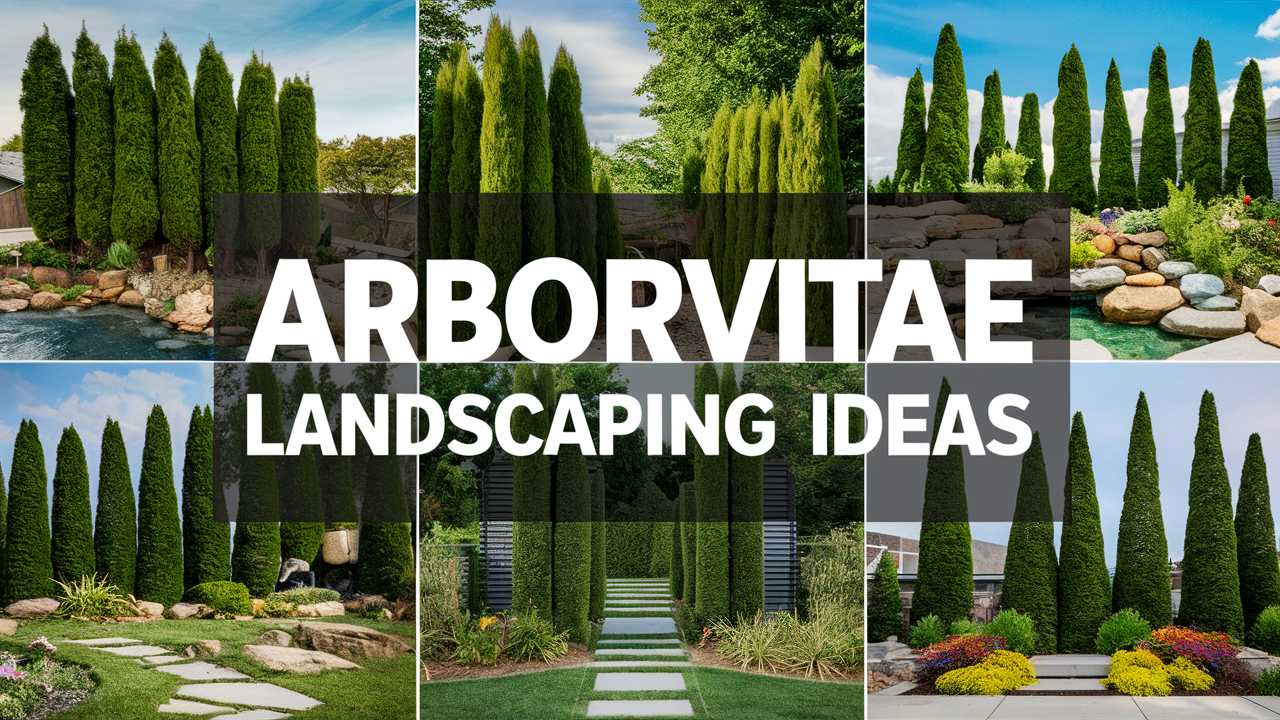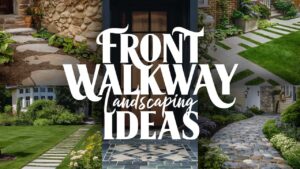Below, we’ll explore unique and compelling Arborvitae landscaping ideas that will inspire you to incorporate this beautiful plant into your outdoor spaces.
View this post on Instagram
Isn’t this stunning? I love the idea of using a row of arborvitae to create a formal, almost Tuscan-style garden border. The height and uniform shape of the trees provide a great backdrop for the lower-lying colorful flowers, like these azaleas. You could swap out the blooms for whatever thrives in your area, though! Plus, the brick path just adds such a classic touch, don’t you think?
View this post on Instagram
I’m really digging this simple but elegant design. A straight row of arborvitae provides a solid green privacy screen, and then a vibrant row of flowering shrubs really pops in front of it. It’s such a classic look that feels both modern and timeless, I think. Plus, it’s relatively easy to maintain which is always a win in my book. A perfect way to add a splash of color to an otherwise green space.
View this post on Instagram
How about something really structured and refined? This garden uses Arborvitae to create defined geometric shapes and a sense of order. I really like the clean lines, it feels very intentional and stately. Adding in the white hydrangeas softens things just enough and keeps the look from being too harsh. To complete the look try adding bright red begonias in the foreground to provide a bold pop of color.
View this post on Instagram
Here’s an idea for you! I like how the arborvitae are lined up in a row, creating a simple green backdrop. The softer, lower plants in front really pop against that dark mulch and add some charm to the area. It really makes the entrance to your home feel inviting! It’s a great way to bring some texture and color to a shady area, don’t you think?
View this post on Instagram
Looking for some privacy? Planting a row of Arborvitae trees like this really creates a nice, natural screen, right? It’s especially cool when they’re all lined up so perfectly; talk about curb appeal! Imagine how different your space would feel with this lush green backdrop. If you’re dealing with a street view or nosy neighbors, this might be the answer.
View this post on Instagram
I really love how this design uses different sizes and shapes of evergreens to create visual interest! The taller arborvitae almost act like natural columns, framing the window and the house. And I am a total sucker for a rounded shrub in a big pot, like the one by the door. It gives everything a polished, finished feel, doesn’t it? You could totally adapt this concept to fit your own space.
View this post on Instagram
How about something like this for some privacy with style? A neat row of Arborvitae along the property line creates a fantastic green wall. To add a touch of whimsy, that beautiful flowering archway over the stone path really draws the eye. And, just look at how the manicured lawn adds a touch of class. It’s simple, elegant, and gives a real sense of secluded garden charm, don’t you think?
View this post on Instagram
This arborvitae planting idea really makes a statement, doesn’t it? I love how it creates such a defined, natural border with the mulch underneath. It’s almost like a green wall, providing privacy and a touch of elegance. Plus, imagine how beautiful it would look as those trees mature and fill out! It feels so peaceful, like a secluded pathway through the woods.
View this post on Instagram
Okay, so this raised bed design is all about texture, right? It features a simple stone wall which is already attractive, but then the arborvitae act as a formal backdrop to the lower hedge. The hedge contrasts to the larger Arborvitae which adds a cool, rounded softness. It is a classic look that feels both manicured and natural at the same time. I can see this really working well for a lot of different yards!
View this post on Instagram
Here’s a thought, how about a walkway lined with those tall, elegant Arborvitae? I think they create such a clean, structured look. It’s pretty awesome and that gravel path with the stepping stones adds a nice touch of texture and character. Add in some smaller bushes and path lights? Nice! I think it would be a really easy way to add some curb appeal to your place.
View this post on Instagram
How about a simple, clean line of globe-shaped arborvitae to edge your walkway? I love how it creates a neat, formal feel without being fussy, and the rounded shape is softer than a straight hedge. Imagine these perfectly trimmed globes against your house and a simple rock bed around them to complete the look. It’s a look that is fairly low maintenance and always looks put together. It’s one of my favorite simple designs and really makes the area look welcoming.
View this post on Instagram
This could add a touch of refined elegance to your yard! See how the golden arborvitae pops in its sleek, modern planter, standing tall among the boxwood hedges? The layout creates a sense of order, while still feeling welcoming. It has got me thinking of all the symmetrical pathways this layout would work well with and just how peaceful this space could be! If you’re into a more formal garden vibe, this could be a real winner.
View this post on Instagram
What I like about this one is how the Arborvitae are used to create a living privacy screen along the side of the house. It really softens the look of the wall, you know? Then, it’s got this whole English garden feel going on with the sculpted boxwoods and winding path. And those pops of color from the yellow tulips and the pink flowers? Just gorgeous! Don’t forget to add some fun statuary to make it truly unique and your own.
View this post on Instagram
This garden really has a secret garden vibe to it, right? The way the arborvitae is shaped into all these cool geometric forms is so fun and unexpected! I love how the gravel path winds through, giving you a real sense of exploring. And those pops of blue hydrangeas are the perfect touch of color to soften all the greenery. Imagine wandering through this on a sunny afternoon – so peaceful!
View this post on Instagram
Ever thought about creating a really defined space like this? Imagine a circular arborvitae hedge creating a secret garden nook in your yard! The gravel path and those perfectly round shrubs leading up to it add a touch of formality. And that urn centered inside is the perfect finishing touch, right? It would be a super calming spot to just chill out, away from everything.
View this post on Instagram
Isn’t that collection of sculpted Arborvitae cool? It’s a fun take on formal landscaping, almost like a whimsical hedge. I think this would make a really interesting border or backdrop for a garden. Imagine them lining a walkway leading to your front door – talk about making a statement! Just a thought, but maybe it’ll spark some inspiration for your project!
Arborvitae Landscaping Ideas: Creating Lush, Green Spaces
When it comes to landscaping, few plants can rival the elegance and versatility of Arborvitae (Thuja). With their rich, evergreen foliage, these conifers have become a staple in gardens, parks, and residential landscapes. Whether you’re looking to create privacy, add structure, or simply beautify your yard, Arborvitae offers a myriad of possibilities. In this blog post, we’ll explore unique and compelling Arborvitae landscaping ideas that will inspire you to incorporate this beautiful plant into your outdoor spaces.
Understanding Arborvitae: Characteristics and Varieties
Before diving into specific landscaping ideas, it’s essential to understand what Arborvitae is and the various types available. Originating from North America and parts of Asia, Arborvitae translates to “tree of life” in Latin, reflecting its historical significance. Arborvitae trees and shrubs are known for their dense scale-like leaves that range in color from deep green to gold, often changing with the seasons.
There are several popular varieties:
Eastern Arborvitae (Thuja occidentalis): Known for its tall, narrow form, this variety is often used as a privacy screen. It can reach heights of 15 to 20 feet, making it an ideal choice for hedges.
Western Arborvitae (Thuja plicata): Maturing slightly taller than its eastern counterpart, the Western Arborvitae is often found in larger landscapes. Its lush foliage and resistance to disease make it a popular choice.
Emerald Green Arborvitae (Thuja occidentalis ‘Smaragd’): This variety features a compact, pyramidal shape, maintaining its vibrant color year-round. It’s a favorite for smaller gardens due to its decorative stature.
Golden Globe Arborvitae (Thuja occidentalis ‘Golden Globe’): With its striking golden-yellow foliage, the Golden Globe variety brightens any garden, particularly in the fall.
Techny Arborvitae (Thuja occidentalis ‘Techny’): This variety is bred for cold-hardiness, and its thick foliage makes it an excellent choice for windbreaks.
Understanding the unique characteristics of these varieties will help you choose the right one based on your climate, space, and landscaping objectives.
Creating Privacy Hedges
One of the primary uses of Arborvitae in landscaping is the creation of privacy hedges. If you live in a suburban area where homes are closely spaced, a tall, dense hedge of Arborvitae can act as an effective screen.
Choosing the Right Spacing
When planting a privacy hedge, consider the height and width of the Arborvitae variety you’ve chosen. For example, Emerald Green Arborvitae grows roughly 3 to 4 feet wide, so planting them 2 to 3 feet apart will create a solid screen without overcrowding. In contrast, the wider Techny Arborvitae may require more spacing.
Layering for Depth
For an aesthetically pleasing hedge, consider layering different varieties of Arborvitae. Place taller varieties, such as Western Arborvitae, in the back and shorter varieties in front. This approach creates depth and texture, enhancing the visual appeal of your landscape.
Maintenance Tips
Maintaining your Arborvitae hedge ensures it remains lush and healthy. Regular watering, especially during dry spells, will help prevent browning or wilting leaves. Pruning should be done annually to maintain shape and promote new growth, ideally in early spring before new growth begins.
Utilizing Arborvitae as Focal Points
While many associate Arborvitae with hedges, these trees can also serve as stunning focal points in a landscape. Their unique shapes and vibrant colors can draw the eye and create a natural centerpiece.
Planting in Mulched Beds
Consider planting a single mature Arborvitae in a circular mulched bed surrounded by decorative stones or perennials. This approach allows the tree to stand out while also providing a neat and tidy appearance. Choose companion plants that bloom at different times of the year to keep the area vibrant through various seasons.
Pairing with Seasonal Flowers
For added beauty, pair your Arborvitae with seasonal flowers. Surround the base with colorful annuals such as petunias, marigolds, or pansies in summer, and switch to fall-friendly blooms like mums or ornamental kale as the seasons change. This creates a dynamic landscape that celebrates seasonal transitions.
Incorporating Hardscapes
Incorporate hardscape features such as benches, paths, or arches to enhance the focal point of an Arborvitae tree. A winding stone path leading to a single Arborvitae can create an inviting atmosphere. Such thoughtful integration of hardscapes elevates the overall aesthetic and functionality of your garden.
Creating Natural Screens and Windbreaks
Arborvitae is particularly useful for creating natural screens or windbreaks that protect your yard from harsh weather conditions. This is especially beneficial in areas prone to strong winds or heavy snows, where a solid line of trees can shield other plants and structures.
Designing a Windbreak
When designing a windbreak, plant Arborvitae in multiple rows, with staggered spacing to maximize coverage. The outermost row can feature taller varieties while inner rows can be shorter, creating an effective barrier. For added protection, consider mixing in other evergreen species that complement the Arborvitae, enhancing both visual interest and windbreak efficacy.
Climate Considerations
Select varieties that are suited to your local climate when creating windbreaks. In colder regions, pick hardier options like Techny Arborvitae, which can withstand colder temperatures. Proper planning based on local conditions ensures the long-term success of your landscaping venture.
Emphasizing Vertical Elements
In modern landscaping, the use of vertical elements is gaining popularity. Arborvitae provides an excellent opportunity to create vertical structure in your yard, drawing the eye upward and adding dimension.
Vertical Gardens
Consider planting Arborvitae in vertical garden formats, where they’re installed in planters or living walls along a fence or wall. This brings greenery up to eye level, enhancing small spaces effectively. The vibrant green of the Arborvitae provides an excellent backdrop for climbing plants or flowers that can add additional color and texture.
Architectural Statements
Use Arborvitae to create architectural statements by planting them in pairs or clusters flanking entryways to homes, driveways, and walkways. This symmetrical planting offers a classic and elegant look. When properly maintained, these team-ups can set the tone for your entire property.
Incorporating Arborvitae in Mixed Borders
A mixed border is a thriving tapestry of colors, shapes, and sizes within a garden. Arborvitae can add structure and balance to these diverse plantings.
Composting and Companion Planting
To achieve a vibrant mixed border, incorporate a variety of flowering plants, shrubs, and grasses alongside your Arborvitae. Aim for a blend of bloom times, textures, and heights. Hostas, astilbes, and daylilies can provide seasonal color, while ornamental grasses add movement and interest.
Seasonal Color Schemes
Consider the seasonal changes to plan your mixed border effectively. For example, during spring, the deep greens of Arborvitae contrast beautifully with pastel blooms of tulips and daffodils. In summer, add colorful perennials and late summer bloomers like coneflowers and black-eyed Susans to enhance this charm.
Enhancing On-Site Aesthetics with Arborvitae
Arborvitae truly shines when used to enhance the natural aesthetics of your landscape. Here are ways to do just that:
Surrounding Pools and Patios
Planting Arborvitae around pools or patios can elevate outdoor spaces. Their height provides privacy while their evergreen nature ensures beauty year-round. Additionally, consider dwarf varieties if space is a concern, maintaining a relaxing atmosphere without overwhelming the area.
Framing Views
Use Arborvitae strategically to frame views or natural landscapes. For instance, plant them along a pathway leading to a picturesque view, guiding visitors as they walk through the garden. The vertical lines brought by the plant will make the view more dramatic and framed.
Eco-Friendly Landscaping with Arborvitae
Incorporating Arborvitae into your landscaping plan is not only aesthetically pleasing but also eco-friendly.
Supporting Local Wildlife
Arborvitae offers shelter and food for many local birds and small mammals. By planting these trees, you contribute to creating habitats for wildlife while also adding natural beauty to your yard. Positioning Arborvitae near birdbaths or feeders can attract even more life to your garden.
Reducing Carbon Footprint
Evergreen plants like Arborvitae help cool the environment while absorbing carbon dioxide. By incorporating them into your landscape, you are actively participating in reducing your carbon footprint and promoting a greener planet.
Conclusion: Your Landscape, Your Vision
Arborvitae landscaping ideas can transform any outdoor space, offering multi-functional uses that range from privacy hedges to stunning focal points. By understanding the characteristics of these versatile trees and planning their placement thoughtfully, you can create a landscape that complements your home, supports local wildlife, and embodies your personal style.





